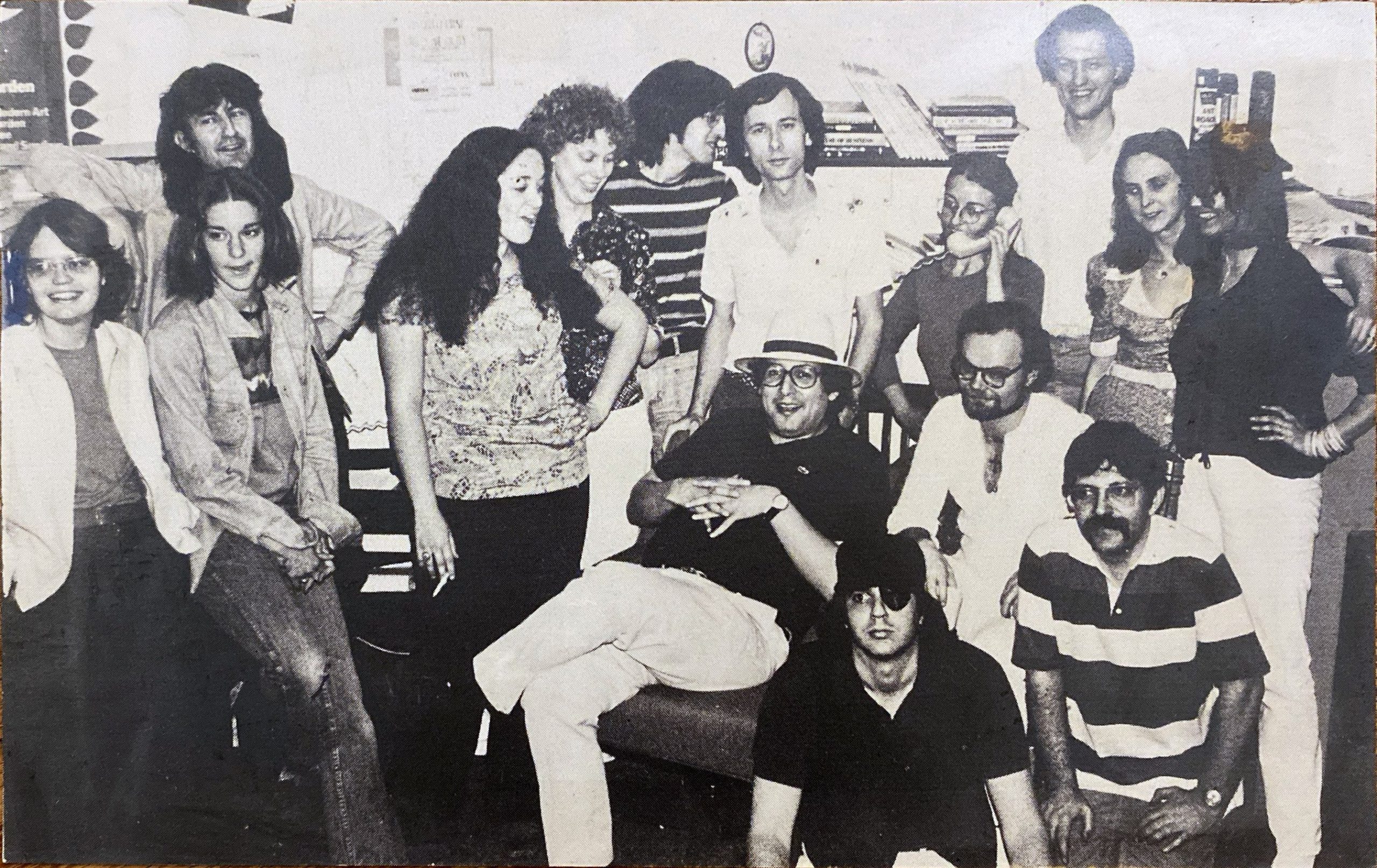The folks pictured above are a small sampling of the talent that made up the Soho Weekly News over its run from 1973 to 1982. Thanks to a generous donation from Allan and Joanna Wolper of their rare, bound collection of 24 volumes of the Soho Weekly News, the newspaper will be preserved when it travels with the rest of the Soho Memory Project Archive to the New York Historical Society, its future home.
But before any of this happens, let’s have a look inside this treasure trove of downtown history with none other than Allan Wolper himself, who has written a Soho Weekly News Who’s Who of sorts, from Edward Gorey and Rex Reed to Bruce Springsteen and beyond. The many boldfaced names included here are a testament to the paper’s journalistic excellence.
The Soho Weekly News was Allan Wolper’s journalism home for more than eight years as an editor and columnist and Joanna contributed numerous stories to the paper. They donated their collection so researchers, scholars, and other inquisitive people could learn what New York City was like during the turbulent seventies.

The Life of the Soho Weekly News
by Allan Wolper
The Soho Weekly News was a journalistic outlier that attracted cutting edge writers, artists, directors, and critics who chronicled the hip, edgy, cultural landscape of the seventies. The writers were fearless and original. They often produced material the media were too reluctant to touch.
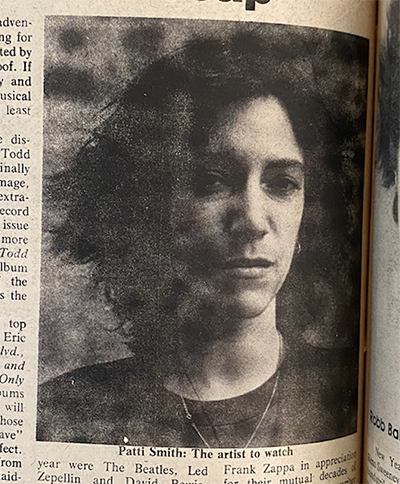
They covered the music, art, theater, film, dance, activism and political life of the period, and kept a sharp journalistic eye on developers and politicians who yearned to raze and replace SoHo’s historic cast-iron buildings. The writers were motivated by issues, not money, and some of them accepted shares of the company instead of checks.
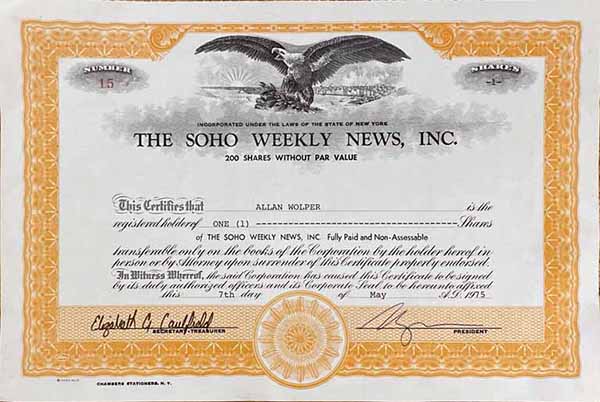
In the process, they created a culture that celebrities wanted to become part of. Investors included singer-songwriter Paul Simon, the late Elaine Kaufman, the owner of “Elaine’s,” the up-scale Manhattan media meeting place, and Louis K. Meisel, owner of The Louis K. Meisel Gallery, which represented Chuck Close and other photorealists.
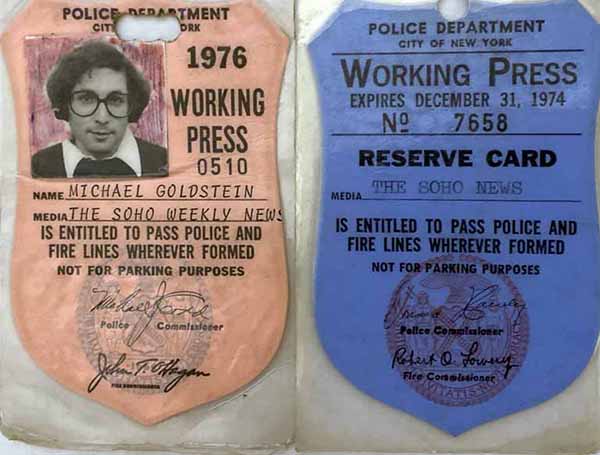
Michael Goldstein, who had promoted Frank Zappa and The Mothers of Invention, Sly and the Family Stone, The Jefferson Airplane, The Grateful Dead and Jimi Hendrix, launched the paper on October 11, 1973, out of a small office in his loft at 450 Broome Street, across the street from The Broome Street Bar.
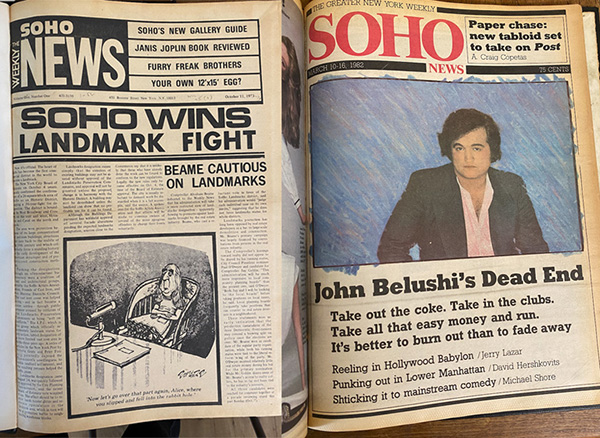
In the first issue, Goldstein pledged to be accountable to his SoHo neighborhood, a promise the paper kept until its financial death more than eight years later with John Belushi on its cover.
“Thank you for picking up our first issue,” he wrote. “We are planning to report what is going on down here honestly and fairly. To do that we need your help – in telling us your problems, filling us in on what is happening and keeping us generally informed.”
Goldstein’s goal was to expand the paper’s influence from its funky downtown SoHo base to all the boroughs in New York City and beyond, which he did. And secondly to surpass The Village Voice as the premier alternative weekly in America. The Soho Weekly News held its own in its editorial war with the rival Voice and more.
The late David Bowie, who spent much of his time in Soho and eventually moved there, said The Soho Weekly News had been “the encyclopedia of the seventies.”
**************
The Soho Weekly News environment was an elixir for young American writers and artists. They were creative, curious and energetic. They enjoyed a freedom they would never experience again. They were true, uninhibited influencers.
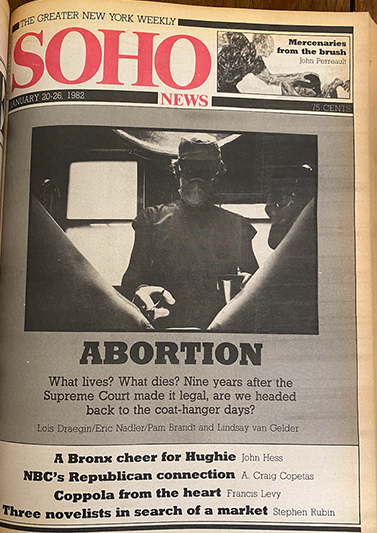
They were unafraid to tackle issues that were even taboo to the alternative press.
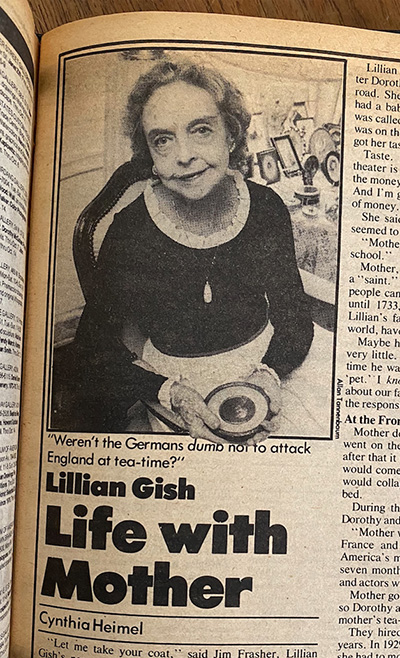
Cynthia Heimel, the Soho Weekly News features editor, produced prose that pierced the sexual taboos of American society. The New York Times said Heimel, “like Dorothy Parker, was an urban romantic with a scathing x-ray vision that penetrates her most deeply cherished fantasies.”
After leaving the paper, Heimel wrote several bestselling books and was a columnist for New York Magazine, The Village Voice, The Daily News, Vogue, and Playboy.
John Calvin Batchelor, an author and conservative radio host on ABC, created a literary fire storm for his 1977 Soho Weekly News story theorizing that Thomas Pynchon was a pseudonym for the super private novelist, J.D. Salinger, a rumor bandied about for years in publishing houses.
Afterwards, Batchelor said he received a letter about his article allegedly signed by Pynchon that said “some of it was true, but none of the interesting parts. Not bad. Keep trying.”
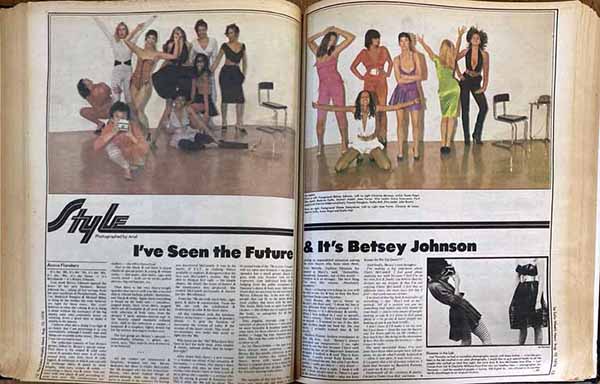
Annie Flanders created a heralded Style section for the newspaper. She later founded Details, a downtown culture magazine she grew to 100 pages. “Nobody wanted to have people with no experience except me,” she once said, a Soho Weekly News anthem. “I was always finding new people who needed that first place to start.”
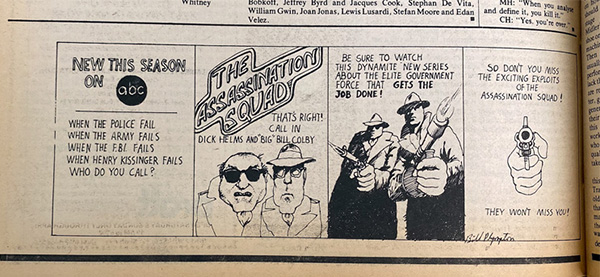
Bill Plympton, a cartoonist and illustrator, began drawing a political cartoon in 1975 for The Soho Weekly News called “Plympton.” He has won two separate Academy Award nominations for his animated shorts, and a Prix Special de Jury at the Cannes Film Festival. His work has appeared in Rolling Stone, Vanity Fair, The National Lampoon, The New York Times and been syndicated in 20 newspapers.
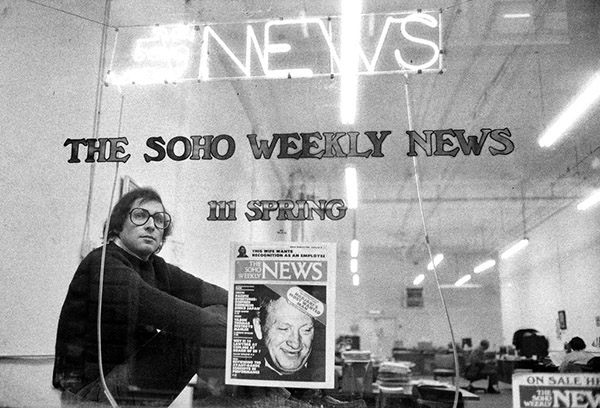
The Early Years
Goldstein recruited people who dared to think outside the box, had an alternative approach to journalism, were controversial, familiar to advertisers, and able to connect with readers. The paper was alive with ideas. It even attracted veteran journalists who reveled in its anti-establishment behavior and didn’t worry that the paper paid them $10 a story. Goldstein needed a special person to direct that kind of paper.
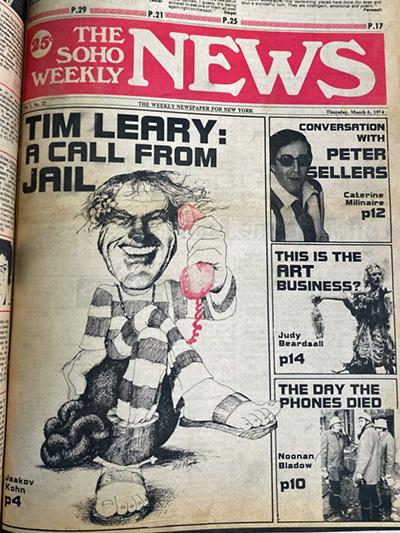
He called Jaakov Kohn, a legendary editor of The East Village Other (EVO), the exotic weekly that The New York Times had called “a New York newspaper so counter-culture it made The Village Voice look like a church circular.”
EVO had folded and Kohn was running a jewelry store on MacDougal Street in Greenwich Village frequented by Jack Kerouac and Bob Dylan. Goldstein convinced Kohn to give up the store and become editor of The Soho Weekly News. The decision had long term benefits.
One of the founders of EVO was Dan Rattiner, who started Dan’s Papers, a slick, upper crust publication in the Hamptons. Rattiner soon was writing a column for The Soho Weekly News and distributing the paper in the Hamptons.
It was a partnership that helped The Soho Weekly News secure standing among the mainline media elite who summered there, even persuading them to invite the paper to join the Hampton softball league. The Soho Weekly News had earned its place on that field for its arts coverage, and as it grew, for its in-depth and investigative work on city issues.

Jim Stratton penned a column, “Keeping Aloft,” as artists renovated legal and illegal lofts and SoHo exploded as a thriving artistic community with galleries on almost every corner. The paper wooed Sidney Zion, a former legal writer for The New York Times and the founder of “Scanlan’s Monthly,” a muckraking magazine that delighted in poking holes in laid back, uptight American society.
Zion wrote a political column and poignant pieces on jazz that found a following among both young and older readers. He received universal acclaim post-Soho for his crusade in the Daily News against work abuse of hospital interns – which a grand jury said contributed to the death of his 18-year-old daughter.

Allan Wolper, a political writer for The Associated Press and The New York Post, received recruitment calls from Goldstein to write an investigative column. Wolper held several titles at the Soho Weekly News, often simultaneously – as columnist, investigative editor and managing editor.
In 1976, Allan Wolper and The Soho Weekly News were chosen to represent “Responsible Alternative Media” at the inaugural convention of The Investigative Reporters and Editors (IRE) at Indiana University.
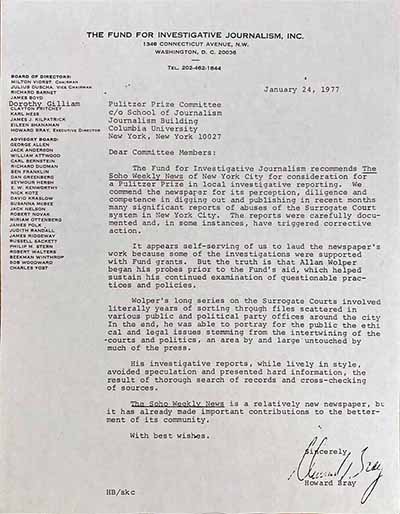
The following year, The Fund For Investigative Journalism, whose board included Bob Woodward and Carl Bernstein, recommended that Wolper and the Soho Weekly News receive the
Pulitzer Prize for investigative journalism.
“We recommend the paper for its perception, diligence and competence in digging out and publishing in recent months many significant reports of abuse in the Surrogate Court system in New York City,” wrote Howard Bray, its executive director. “The Soho Weekly News is a relatively new paper, but it has already made important contributions to the betterment of its community.”
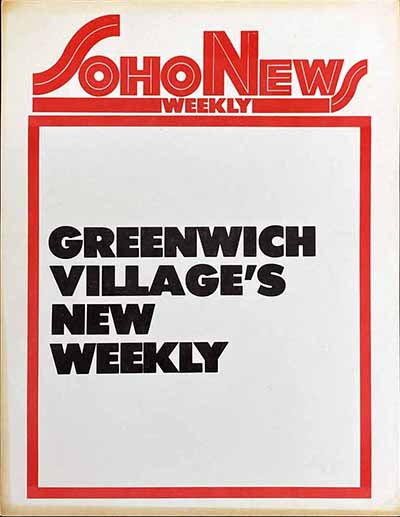
When WNEW-TV (now Fox 10 o’clock News) the highest rated independent television station in New York City broadcast a feature equating The Soho Weekly News with The Village Voice, it got a loud reaction from the Voice. “They had me on the phone complaining for an hour,” Mark Monsky, the station’s general manager, said at the time.
The Voice had already begun to feel the competition. Its editors had warned freelance contributors they would not be allowed to work there if they were caught writing for The Soho Weekly News. The major newsstand in Greenwich Village had placed The Soho Weekly News next to The Village Voice – a not so subtle announcement that the Broome Street paper had made it.
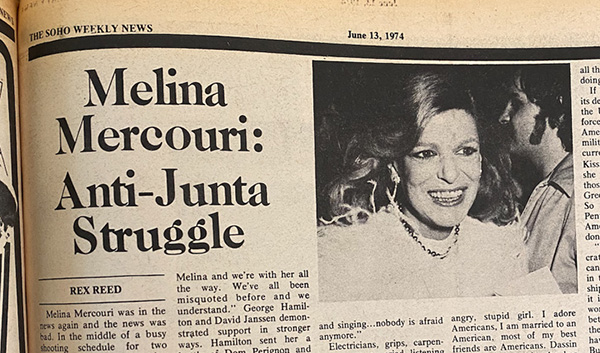
Rex Reed, who had worked for The New York Times, New York Magazine, GQ, Woman’s Wear Daily, The Daily News, joined The Soho Weekly News as a film critic. He later wrote a column for The New York Observer, until recently owned by Jared Kushner, son-in-law of former President Donald J. Trump. Kushner has since sold the paper to his family’s trust.
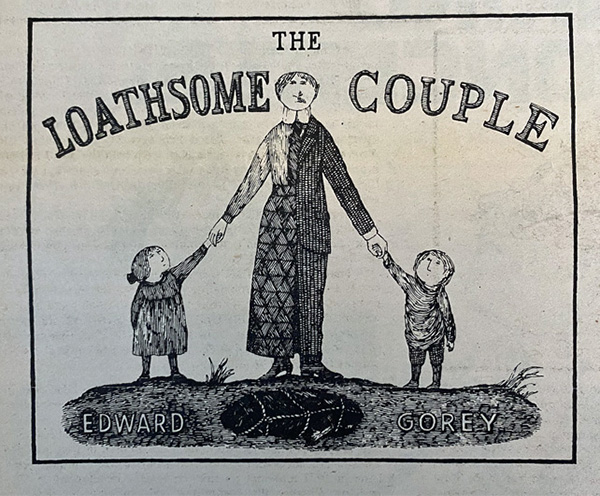
Edward St. John Gorey, whose illustrations adorned books by H.G. Wells, T.S. Elliot, John Updike and Charles Dickens, wrote a film column under the pseudonym “Wadore Edgy.” Goreyana, a blog that celebrated Gorey’s work, noted most reviewers tempered their criticism with praise. “Mr. Edgy had no such scruples and goes for the throat nine out of 10 times,” Goreyana said.
Paul Krassner, one of the greatest all around talents in American alternative culture and one of its most respected voices, also became a columnist. Krassner, a standup comic, was a protégé of Lenny Bruce. He was the founder of “The Realist,” which he said practiced “investigative satire.” He also was a professional prankster.
He once sent out a press release announcing his demise. “Are you sure,” asked a reporter from The Associated Press. “Of course,” Krassner reportedly responded. “I always said I would tell you when I was dead.”
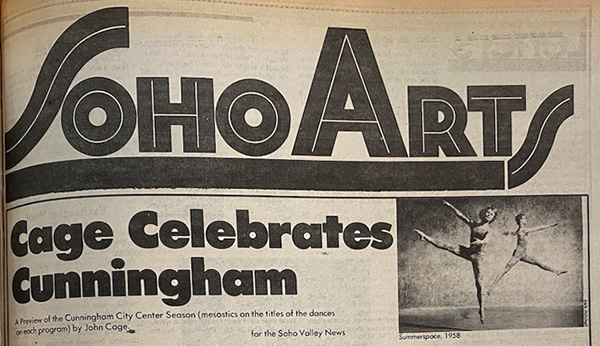
Soho Weekly News writers haunted the clubs of the Soho district and increasingly the entire downtown area. They searched everywhere for new talent, but still kept up with the best of the city’s dance, music, theatrical and political life. And they were part of that life.
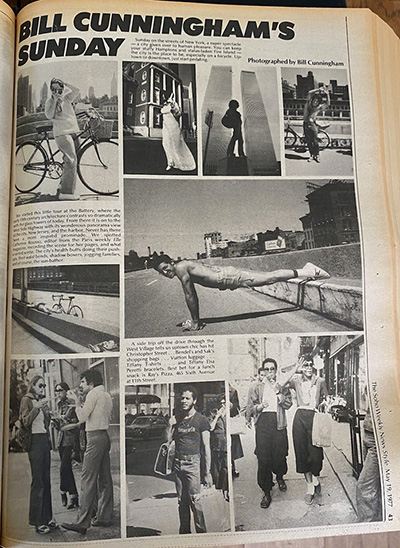
Kim Hastreiter became style editor on the recommendation of New York Times fashion street photographer Bill Cunningham, who admired the outfits she wore.
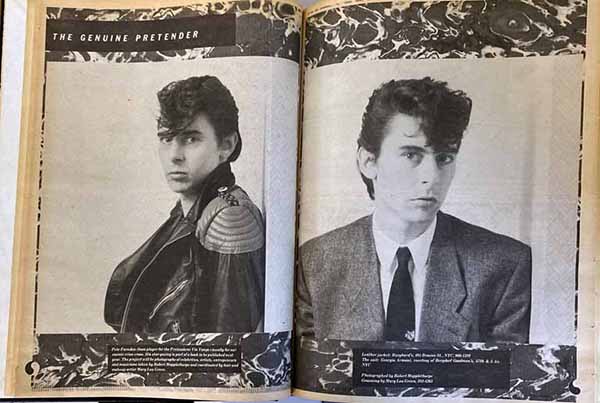
Hastreiter had long been a fully credited member of the Downtown scene. At the paper, she used the talent she found to pose in her fashion section, including Keith Haring, controversial black and white photographer Robert Mapplethorpe and painter Kenny Scharf.
“Put me in a room with 30 billionaires and one artist and I’ll find the artist,” she once told an interviewer. “I have zero ability to smell money. But I am a heat seeking missile for talent.”
After The Soho Weekly News folded, Hastreiter co-founded Paper Magazine with The Soho Weekly News assistant managing editor David Hershkovits.
The Soho Weekly News art staff was filed with journalistic missiles as well.
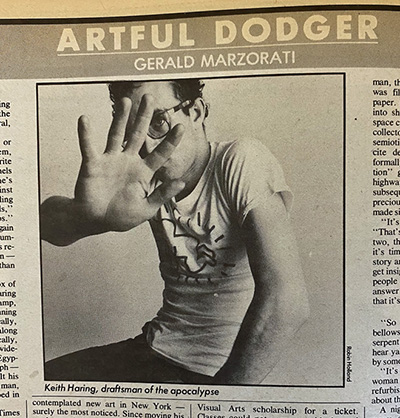
Gerald Marzorati, a Soho Weekly News art editor who wrote the paper’s Artful Dodger column, produced the first major story on Keith Haring before his subway, street and wall graffiti became a cultural sensation.
Marzorati’s vision of the paper was instructive. “We are the alternative weekly that avoids the pitfalls of underground journalism – like self-indulgent, first person writing. Soho News gears itself to the young, cultured Manhattanite and the art world professional,” he said.
Marzorati went on to become the editor of The New York Times Magazine.
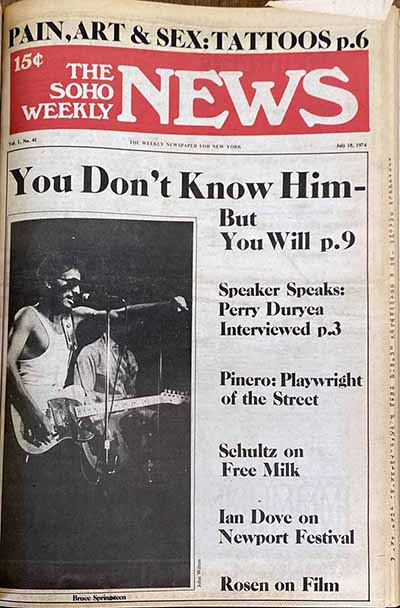
Paul Williams, the famed rock writer who founded “Crawdaddy,” ignored the recording naysayers who threatened to shut down Bruce Springsteen because of low record sales. Williams captured the essence of The Boss with his July 18, 1974 piece, one year before Springsteen came out with his super hit, “Born to Run.”
“He’s the new Elvis Presley, the new Chuck Berry, the new Tommy Dorsey,” Williams wrote in a review in The Soho Weekly News. “Bruce Springsteen could be the next anything.”
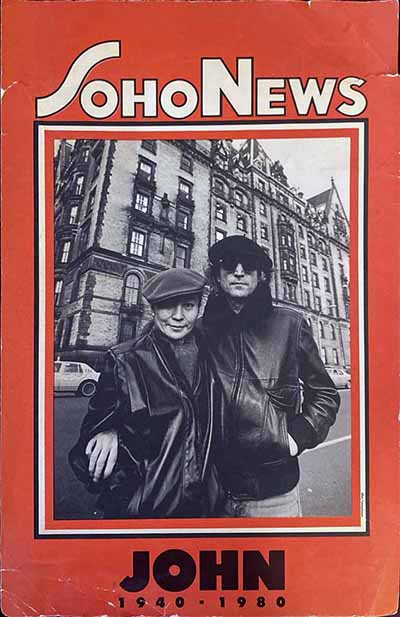
Allan Tannenbaum, a Soho Weekly News photo editor, developed a close personal relationship with John Lennon and his wife, Yoko Ono. Tannenbaum’s candid photos of the couple just days before Lennon was assassinated in front of their Dakota coop apartment building on Central Park West are universally applauded for their sensitive style.
Yoko Ono said as much in an introduction to New York in the Seventies, a book Tannenbaum wrote that included his photo sessions with John and Yoko.
“The stuff that Allan did of John is now history,” she wrote. “Whenever I see those photos taken at the park bench in what later became Strawberry Fields…still chokes me up…,” adding, “Thank you for those moments…Love Yoko.”
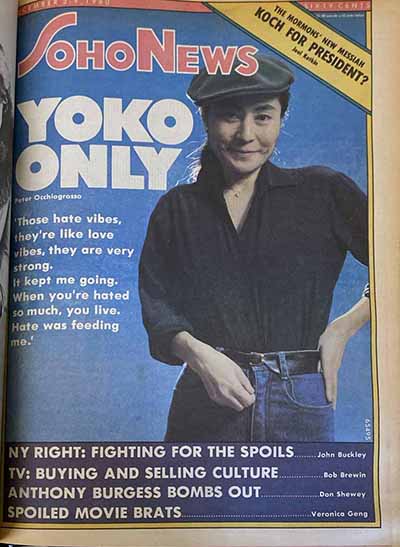
The Soho Weekly News published a cover story called “Yoko Only” five days before Lennon was killed that she praised in her introduction to Tannenbaum’s book.
Peter Occhiogrosso, who wrote the Yoko Ono cover story, had spent an evening at a recording studio with the couple before John died. Occhiogrosso still mourns for Lennon. “He was one of a handful of public figures whose absence was especially painful because we could use their voices and leadership at a time of enormous turmoil,” Occhiogrosso wrote.
In May, 1978, Vere Harmsworth, the head of England’s Associated Newspaper Group, bought 25 percent of The Soho Weekly News. The media played it as a rerun of the long running feud between Harmsworth and Rupert Murdoch, who had bought The Voice the year before.
In 1979, Harmsworth bought out Michael Goldstein and took over the paper. Writers who had opted to receive shares of The Soho Weekly News in lieu of cash received $5000 for each share they owned. Three years later, on March 11, 1982, John Leese, the Harmsworth-installed publisher and editor-in-chief, shut down the newspaper, citing what he called substantial monetary losses.
The closing of The Soho Weekly News signaled the end of an era that had fostered an exuberant art community. The Soho neighborhood gradually changed, replaced by ultra-gentrified stores and restaurants, leading to the displacement of the artists and the galleries that showcased their work.
*********************
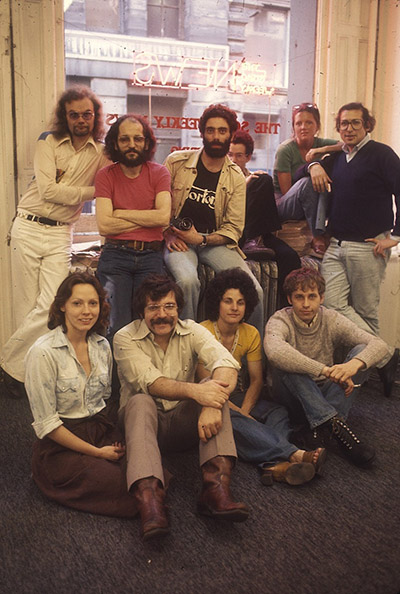
About Allan Wolper
Allan Wolper is Professor Emeritus of Journalism at Rutgers University. He created and directed the journalism program at Rutgers-Newark at the same time he was editing stories and writing a weekly column for The Soho Weekly News. Soho taught him how to look at stories with an alternative eye while Rutgers encouraged him to widen his journalism experience.
He created, hosted and produced original and innovative programing for radio, television and multi-media for WBGO-FM radio, the New York area NPR jazz station, Suburban Cable of New Jersey, WNYC-TV and New Jersey Network. He often combined mini-documentaries with daring interviews.
The subjects of the interviews were on the cutting edge of American life, often changing the way people thought. They included ABSCAM-scarred New Jersey Senator Harrison Williams, who he interviewed at the Federal Prison at Allenwood, Pa.; the Imperial Wizard of the Ku Klux Klan, a controversial juror in The Central Park Jogger rape case, and Frank Lucas, the notorious drug lord featured in the film, American Gangster.
Wolper hosted and produced audio biographies on life changers, like Dr. Michael Crane, who treated victims of the World Trade Center bombing; Annette Gordon-Reed, the Harvard Law Professor whose Pulitzer Prize winning book revealed Thomas Jefferson had seven children with Sally Hemmings, one of his slaves; and Frank Casey, the investigator who uncovered the Bernard Madoff scandal. Other audio biographies included political figures at the beginning of their careers, like New York State Attorney General Letitia James and New York City Mayor Bill de Blasio and legacy conversations with Mayors David Dinkins and Edward I. Koch.
The more he studied the coverage of both boldface and ordinary people, the more he was determined to learn about the media process. It led him to start a media column for Editor & Publisher Magazine that lasted for ten years.
Wolper has won more than 50 awards in every medium of journalism, including The Alfred I. duPont-Columbia University Award – the Pulitzer Prize of Broadcast News. The documentary Hillside: A Desegregation Story was the first cable produced program in history to win the coveted prize.
Other awards include Best Column from The New York Chapter of The Society of Professional Journalists; the Distinguished Service Award from the National Society of Professional Journalists for a documentary on The Bill of Rights, a National Headliner prize for radio commentary on WBGO, three National Cable Television (ACE) awards and a New York Emmy nomination.
His work has been honored by The Medill School of Journalism at Northwestern, Penn State and the University of Florida.
His radio program/podcast, Conversations with Allan Wolper, a series of more than 100 audio biographies, is available on WBGO Digital, The Public Radio Exchange, iHeart.com and Apple podcasts.

